ExcelIT Case Study: ISO/IEC 20000 Implementation - CIS5308 Report
VerifiedAdded on 2023/06/14
|13
|3157
|215
Case Study
AI Summary
This case study examines the implementation of ISO/IEC 20000 in ExcelIT, an Australian IT company, focusing on the benefits, challenges, and approaches involved in adopting the standard. The report discusses the importance of service management systems (SMS) and their integration with IT service management (ITSM), highlighting the role of ISO/IEC 20000 in enhancing service quality and customer satisfaction. It details the journey of implementing the standard, including planning, gap analysis, redesigning processes, and iterative improvements, while also addressing common challenges such as lack of management commitment and structural changes. The study recommends an iterative model for implementation in ExcelIT and emphasizes the key benefits of ISO/IEC 20000 certification, such as improved coordination between support and service delivery teams, recognition of support team contributions, and enhanced service ownership, ultimately justifying the relevance and long-term benefits of implementing the standard for ExcelIT.
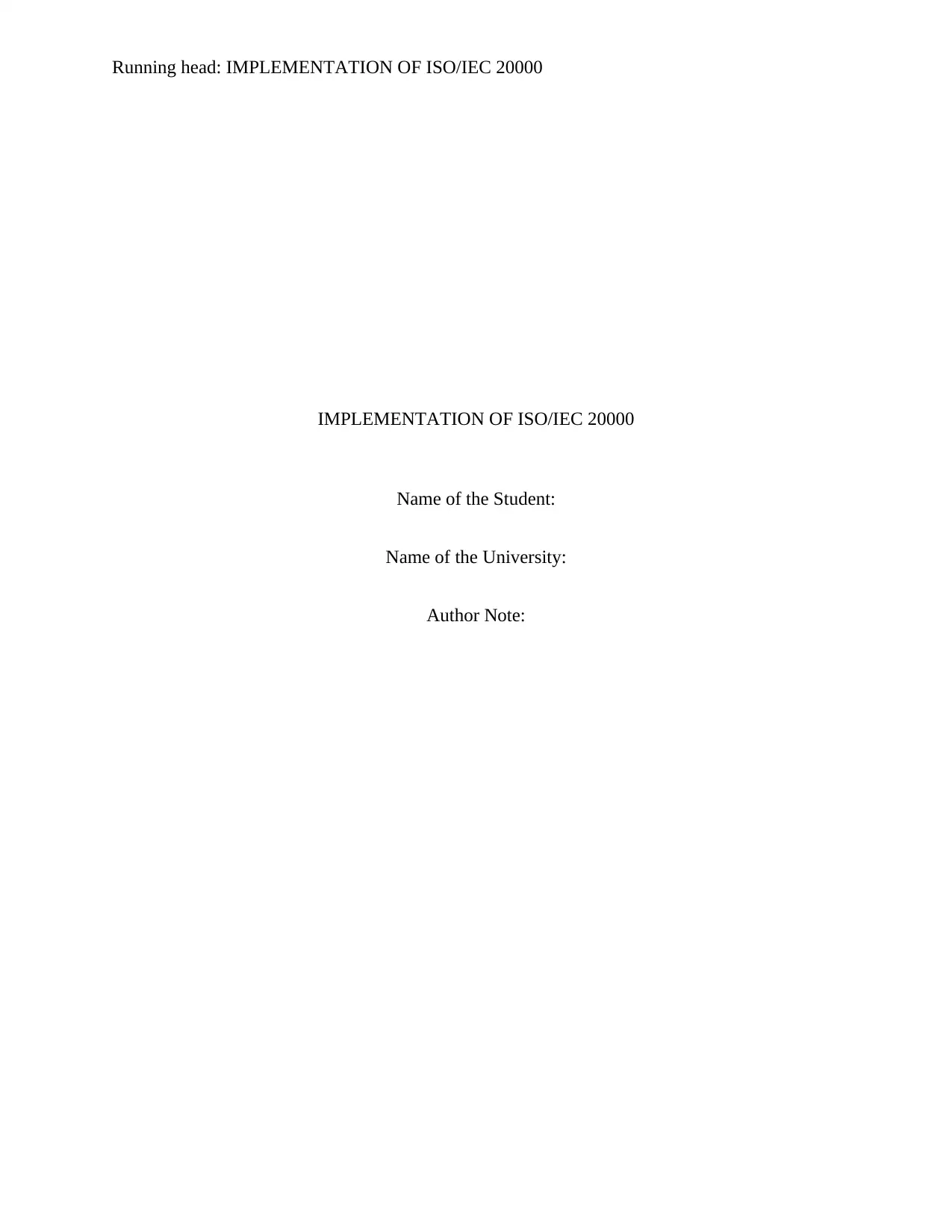
Running head: IMPLEMENTATION OF ISO/IEC 20000
IMPLEMENTATION OF ISO/IEC 20000
Name of the Student:
Name of the University:
Author Note:
IMPLEMENTATION OF ISO/IEC 20000
Name of the Student:
Name of the University:
Author Note:
Paraphrase This Document
Need a fresh take? Get an instant paraphrase of this document with our AI Paraphraser
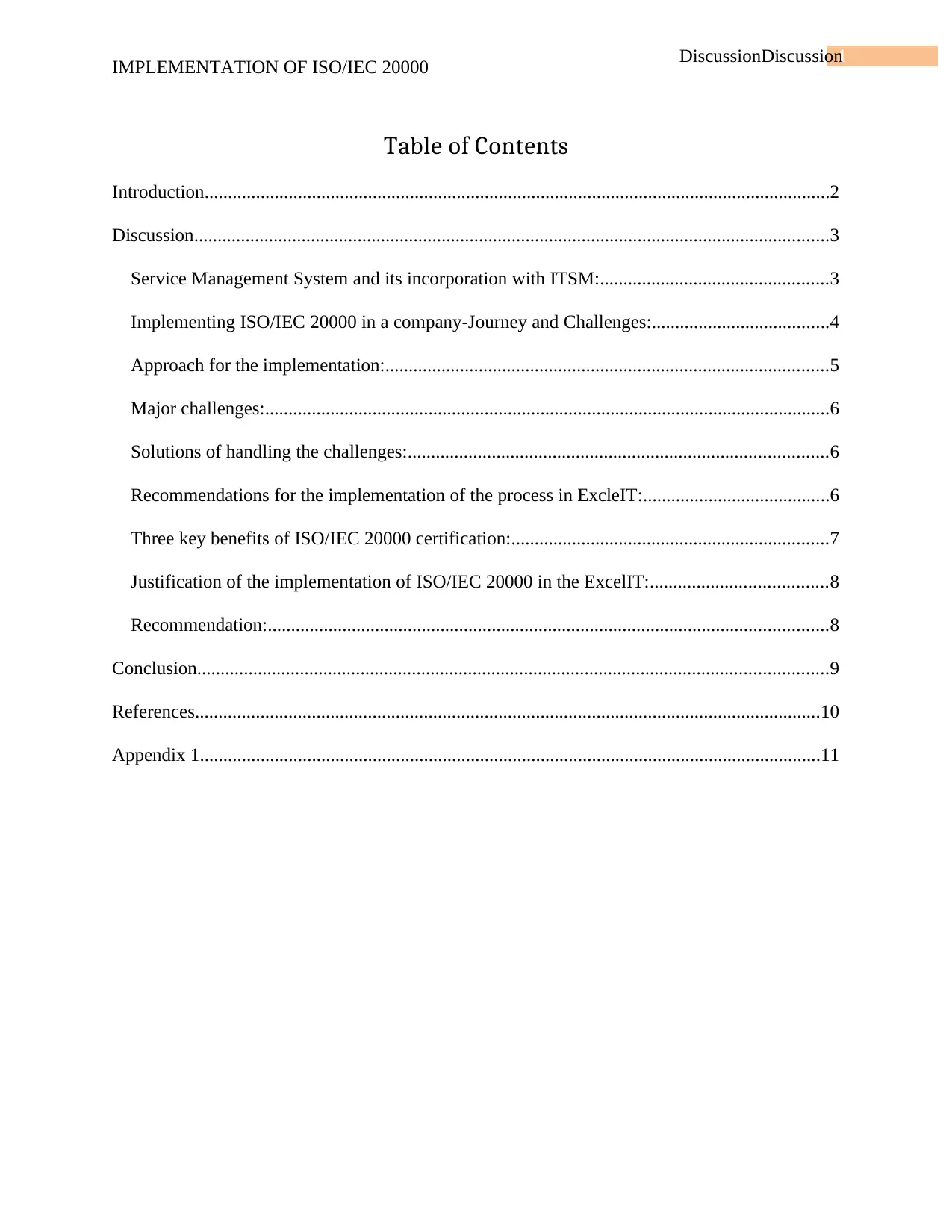
1DiscussionDiscussion
IMPLEMENTATION OF ISO/IEC 20000
Table of Contents
Introduction......................................................................................................................................2
Discussion........................................................................................................................................3
Service Management System and its incorporation with ITSM:.................................................3
Implementing ISO/IEC 20000 in a company-Journey and Challenges:......................................4
Approach for the implementation:...............................................................................................5
Major challenges:.........................................................................................................................6
Solutions of handling the challenges:..........................................................................................6
Recommendations for the implementation of the process in ExcleIT:........................................6
Three key benefits of ISO/IEC 20000 certification:....................................................................7
Justification of the implementation of ISO/IEC 20000 in the ExcelIT:......................................8
Recommendation:........................................................................................................................8
Conclusion.......................................................................................................................................9
References......................................................................................................................................10
Appendix 1.....................................................................................................................................11
IMPLEMENTATION OF ISO/IEC 20000
Table of Contents
Introduction......................................................................................................................................2
Discussion........................................................................................................................................3
Service Management System and its incorporation with ITSM:.................................................3
Implementing ISO/IEC 20000 in a company-Journey and Challenges:......................................4
Approach for the implementation:...............................................................................................5
Major challenges:.........................................................................................................................6
Solutions of handling the challenges:..........................................................................................6
Recommendations for the implementation of the process in ExcleIT:........................................6
Three key benefits of ISO/IEC 20000 certification:....................................................................7
Justification of the implementation of ISO/IEC 20000 in the ExcelIT:......................................8
Recommendation:........................................................................................................................8
Conclusion.......................................................................................................................................9
References......................................................................................................................................10
Appendix 1.....................................................................................................................................11
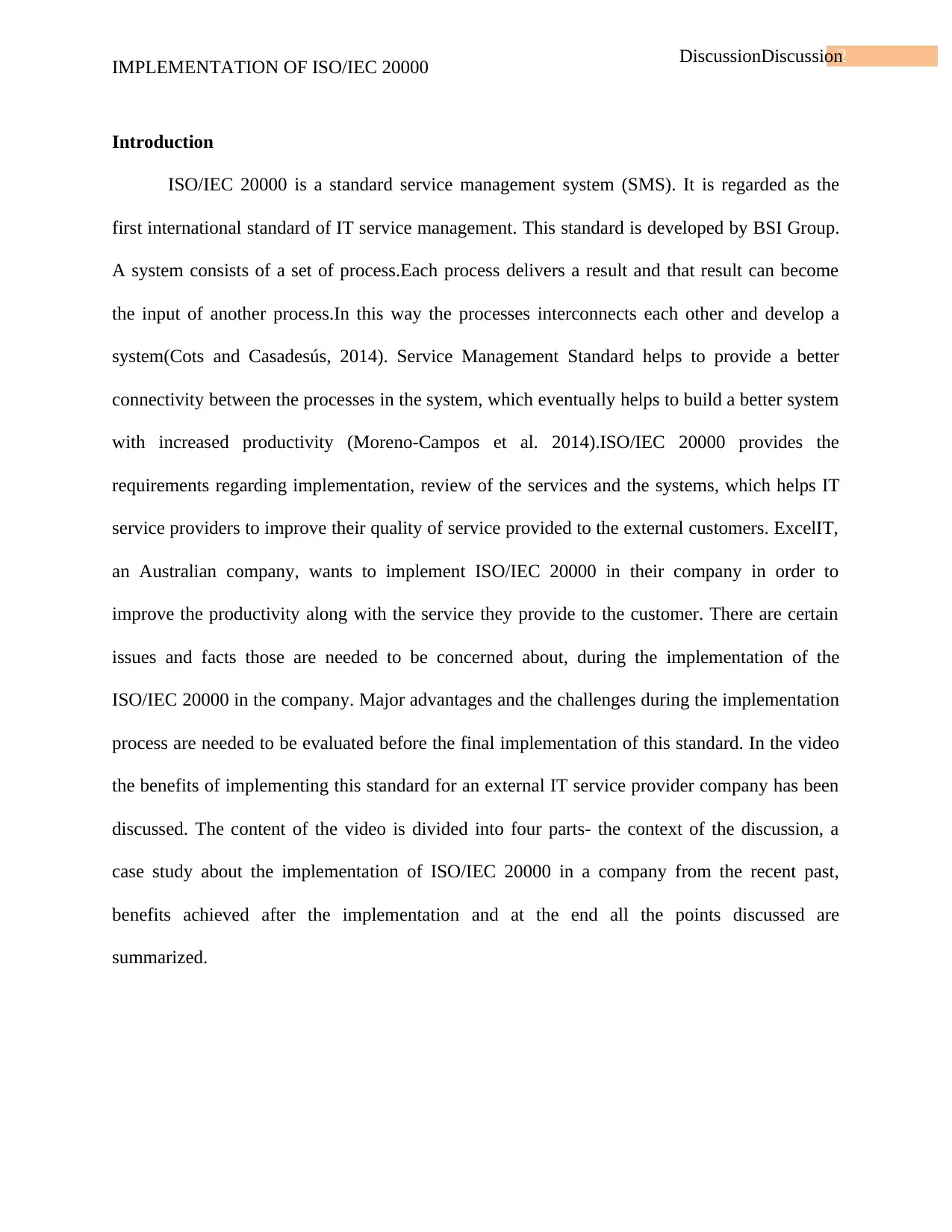
2DiscussionDiscussion
IMPLEMENTATION OF ISO/IEC 20000
Introduction
ISO/IEC 20000 is a standard service management system (SMS). It is regarded as the
first international standard of IT service management. This standard is developed by BSI Group.
A system consists of a set of process.Each process delivers a result and that result can become
the input of another process.In this way the processes interconnects each other and develop a
system(Cots and Casadesús, 2014). Service Management Standard helps to provide a better
connectivity between the processes in the system, which eventually helps to build a better system
with increased productivity (Moreno-Campos et al. 2014).ISO/IEC 20000 provides the
requirements regarding implementation, review of the services and the systems, which helps IT
service providers to improve their quality of service provided to the external customers. ExcelIT,
an Australian company, wants to implement ISO/IEC 20000 in their company in order to
improve the productivity along with the service they provide to the customer. There are certain
issues and facts those are needed to be concerned about, during the implementation of the
ISO/IEC 20000 in the company. Major advantages and the challenges during the implementation
process are needed to be evaluated before the final implementation of this standard. In the video
the benefits of implementing this standard for an external IT service provider company has been
discussed. The content of the video is divided into four parts- the context of the discussion, a
case study about the implementation of ISO/IEC 20000 in a company from the recent past,
benefits achieved after the implementation and at the end all the points discussed are
summarized.
IMPLEMENTATION OF ISO/IEC 20000
Introduction
ISO/IEC 20000 is a standard service management system (SMS). It is regarded as the
first international standard of IT service management. This standard is developed by BSI Group.
A system consists of a set of process.Each process delivers a result and that result can become
the input of another process.In this way the processes interconnects each other and develop a
system(Cots and Casadesús, 2014). Service Management Standard helps to provide a better
connectivity between the processes in the system, which eventually helps to build a better system
with increased productivity (Moreno-Campos et al. 2014).ISO/IEC 20000 provides the
requirements regarding implementation, review of the services and the systems, which helps IT
service providers to improve their quality of service provided to the external customers. ExcelIT,
an Australian company, wants to implement ISO/IEC 20000 in their company in order to
improve the productivity along with the service they provide to the customer. There are certain
issues and facts those are needed to be concerned about, during the implementation of the
ISO/IEC 20000 in the company. Major advantages and the challenges during the implementation
process are needed to be evaluated before the final implementation of this standard. In the video
the benefits of implementing this standard for an external IT service provider company has been
discussed. The content of the video is divided into four parts- the context of the discussion, a
case study about the implementation of ISO/IEC 20000 in a company from the recent past,
benefits achieved after the implementation and at the end all the points discussed are
summarized.
You're viewing a preview
Unlock full access by subscribing today!
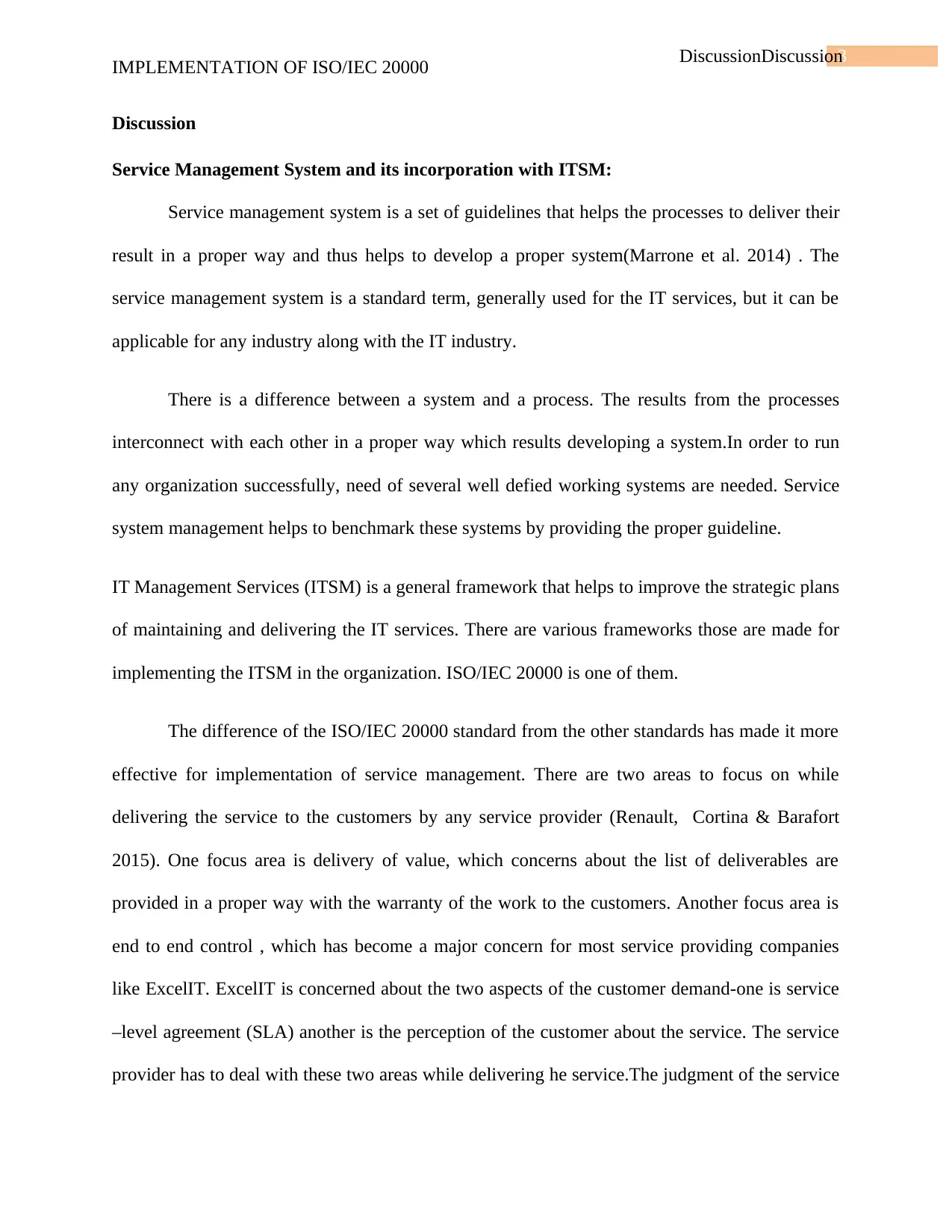
3DiscussionDiscussion
IMPLEMENTATION OF ISO/IEC 20000
Discussion
Service Management System and its incorporation with ITSM:
Service management system is a set of guidelines that helps the processes to deliver their
result in a proper way and thus helps to develop a proper system(Marrone et al. 2014) . The
service management system is a standard term, generally used for the IT services, but it can be
applicable for any industry along with the IT industry.
There is a difference between a system and a process. The results from the processes
interconnect with each other in a proper way which results developing a system.In order to run
any organization successfully, need of several well defied working systems are needed. Service
system management helps to benchmark these systems by providing the proper guideline.
IT Management Services (ITSM) is a general framework that helps to improve the strategic plans
of maintaining and delivering the IT services. There are various frameworks those are made for
implementing the ITSM in the organization. ISO/IEC 20000 is one of them.
The difference of the ISO/IEC 20000 standard from the other standards has made it more
effective for implementation of service management. There are two areas to focus on while
delivering the service to the customers by any service provider (Renault, Cortina & Barafort
2015). One focus area is delivery of value, which concerns about the list of deliverables are
provided in a proper way with the warranty of the work to the customers. Another focus area is
end to end control , which has become a major concern for most service providing companies
like ExcelIT. ExcelIT is concerned about the two aspects of the customer demand-one is service
–level agreement (SLA) another is the perception of the customer about the service. The service
provider has to deal with these two areas while delivering he service.The judgment of the service
IMPLEMENTATION OF ISO/IEC 20000
Discussion
Service Management System and its incorporation with ITSM:
Service management system is a set of guidelines that helps the processes to deliver their
result in a proper way and thus helps to develop a proper system(Marrone et al. 2014) . The
service management system is a standard term, generally used for the IT services, but it can be
applicable for any industry along with the IT industry.
There is a difference between a system and a process. The results from the processes
interconnect with each other in a proper way which results developing a system.In order to run
any organization successfully, need of several well defied working systems are needed. Service
system management helps to benchmark these systems by providing the proper guideline.
IT Management Services (ITSM) is a general framework that helps to improve the strategic plans
of maintaining and delivering the IT services. There are various frameworks those are made for
implementing the ITSM in the organization. ISO/IEC 20000 is one of them.
The difference of the ISO/IEC 20000 standard from the other standards has made it more
effective for implementation of service management. There are two areas to focus on while
delivering the service to the customers by any service provider (Renault, Cortina & Barafort
2015). One focus area is delivery of value, which concerns about the list of deliverables are
provided in a proper way with the warranty of the work to the customers. Another focus area is
end to end control , which has become a major concern for most service providing companies
like ExcelIT. ExcelIT is concerned about the two aspects of the customer demand-one is service
–level agreement (SLA) another is the perception of the customer about the service. The service
provider has to deal with these two areas while delivering he service.The judgment of the service
Paraphrase This Document
Need a fresh take? Get an instant paraphrase of this document with our AI Paraphraser
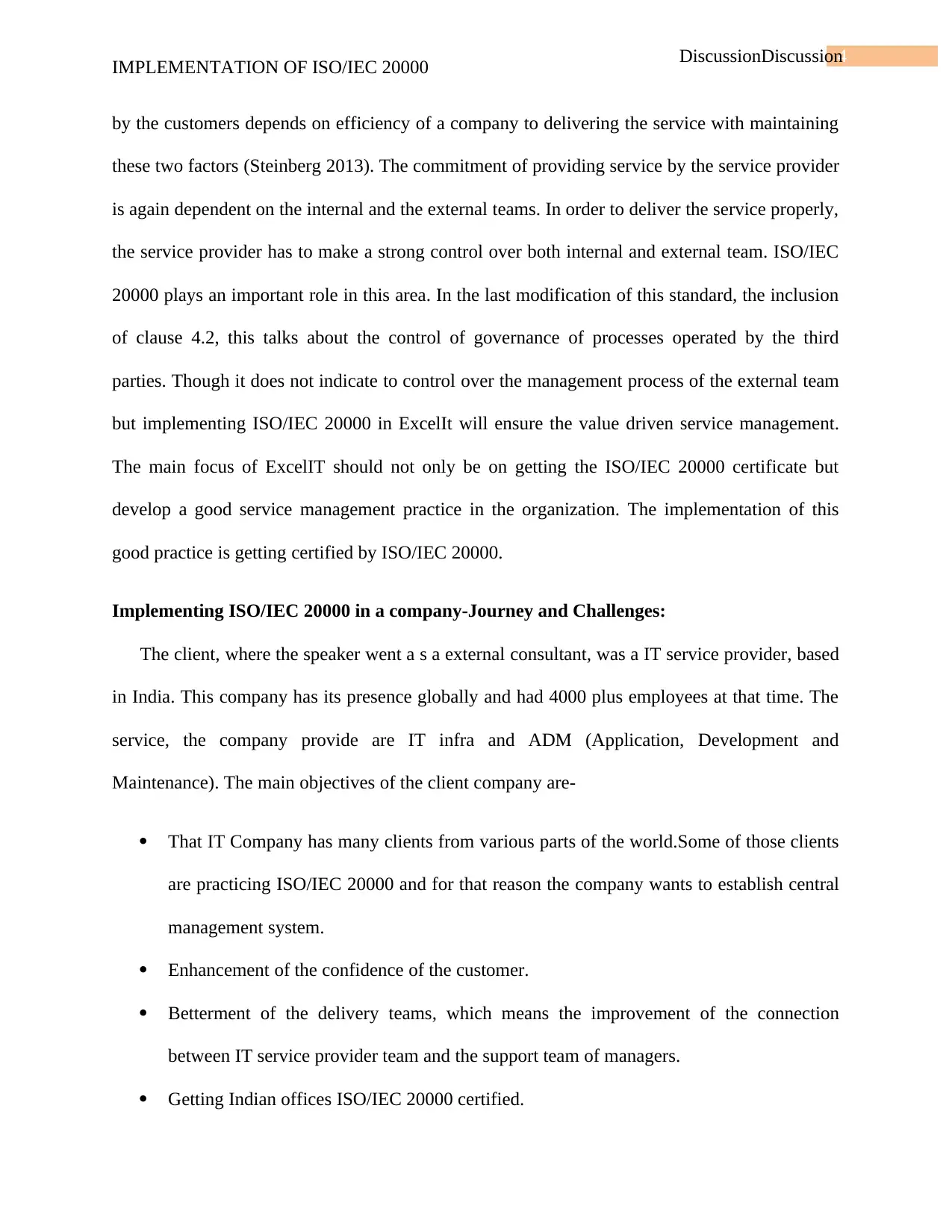
4DiscussionDiscussion
IMPLEMENTATION OF ISO/IEC 20000
by the customers depends on efficiency of a company to delivering the service with maintaining
these two factors (Steinberg 2013). The commitment of providing service by the service provider
is again dependent on the internal and the external teams. In order to deliver the service properly,
the service provider has to make a strong control over both internal and external team. ISO/IEC
20000 plays an important role in this area. In the last modification of this standard, the inclusion
of clause 4.2, this talks about the control of governance of processes operated by the third
parties. Though it does not indicate to control over the management process of the external team
but implementing ISO/IEC 20000 in ExcelIt will ensure the value driven service management.
The main focus of ExcelIT should not only be on getting the ISO/IEC 20000 certificate but
develop a good service management practice in the organization. The implementation of this
good practice is getting certified by ISO/IEC 20000.
Implementing ISO/IEC 20000 in a company-Journey and Challenges:
The client, where the speaker went a s a external consultant, was a IT service provider, based
in India. This company has its presence globally and had 4000 plus employees at that time. The
service, the company provide are IT infra and ADM (Application, Development and
Maintenance). The main objectives of the client company are-
That IT Company has many clients from various parts of the world.Some of those clients
are practicing ISO/IEC 20000 and for that reason the company wants to establish central
management system.
Enhancement of the confidence of the customer.
Betterment of the delivery teams, which means the improvement of the connection
between IT service provider team and the support team of managers.
Getting Indian offices ISO/IEC 20000 certified.
IMPLEMENTATION OF ISO/IEC 20000
by the customers depends on efficiency of a company to delivering the service with maintaining
these two factors (Steinberg 2013). The commitment of providing service by the service provider
is again dependent on the internal and the external teams. In order to deliver the service properly,
the service provider has to make a strong control over both internal and external team. ISO/IEC
20000 plays an important role in this area. In the last modification of this standard, the inclusion
of clause 4.2, this talks about the control of governance of processes operated by the third
parties. Though it does not indicate to control over the management process of the external team
but implementing ISO/IEC 20000 in ExcelIt will ensure the value driven service management.
The main focus of ExcelIT should not only be on getting the ISO/IEC 20000 certificate but
develop a good service management practice in the organization. The implementation of this
good practice is getting certified by ISO/IEC 20000.
Implementing ISO/IEC 20000 in a company-Journey and Challenges:
The client, where the speaker went a s a external consultant, was a IT service provider, based
in India. This company has its presence globally and had 4000 plus employees at that time. The
service, the company provide are IT infra and ADM (Application, Development and
Maintenance). The main objectives of the client company are-
That IT Company has many clients from various parts of the world.Some of those clients
are practicing ISO/IEC 20000 and for that reason the company wants to establish central
management system.
Enhancement of the confidence of the customer.
Betterment of the delivery teams, which means the improvement of the connection
between IT service provider team and the support team of managers.
Getting Indian offices ISO/IEC 20000 certified.
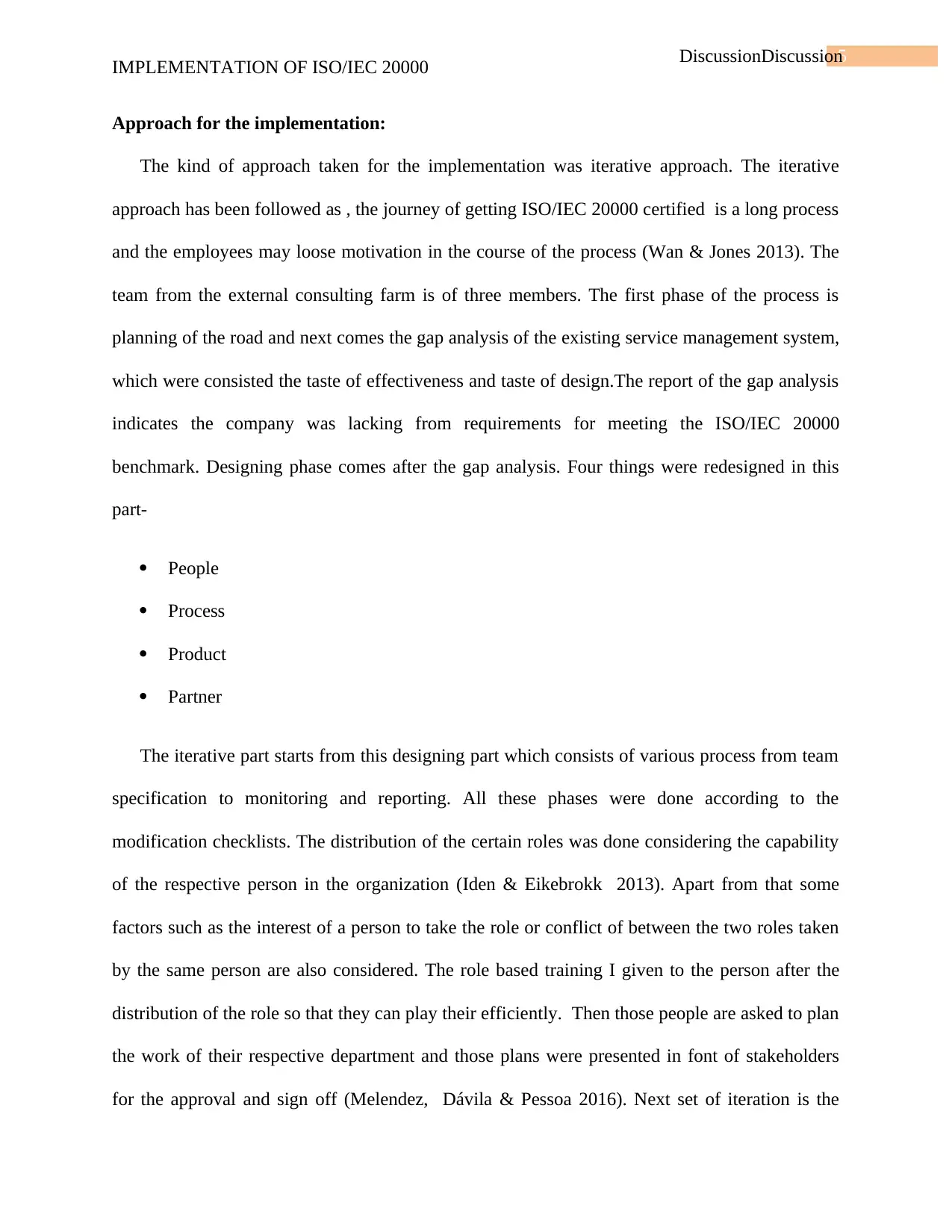
5DiscussionDiscussion
IMPLEMENTATION OF ISO/IEC 20000
Approach for the implementation:
The kind of approach taken for the implementation was iterative approach. The iterative
approach has been followed as , the journey of getting ISO/IEC 20000 certified is a long process
and the employees may loose motivation in the course of the process (Wan & Jones 2013). The
team from the external consulting farm is of three members. The first phase of the process is
planning of the road and next comes the gap analysis of the existing service management system,
which were consisted the taste of effectiveness and taste of design.The report of the gap analysis
indicates the company was lacking from requirements for meeting the ISO/IEC 20000
benchmark. Designing phase comes after the gap analysis. Four things were redesigned in this
part-
People
Process
Product
Partner
The iterative part starts from this designing part which consists of various process from team
specification to monitoring and reporting. All these phases were done according to the
modification checklists. The distribution of the certain roles was done considering the capability
of the respective person in the organization (Iden & Eikebrokk 2013). Apart from that some
factors such as the interest of a person to take the role or conflict of between the two roles taken
by the same person are also considered. The role based training I given to the person after the
distribution of the role so that they can play their efficiently. Then those people are asked to plan
the work of their respective department and those plans were presented in font of stakeholders
for the approval and sign off (Melendez, Dávila & Pessoa 2016). Next set of iteration is the
IMPLEMENTATION OF ISO/IEC 20000
Approach for the implementation:
The kind of approach taken for the implementation was iterative approach. The iterative
approach has been followed as , the journey of getting ISO/IEC 20000 certified is a long process
and the employees may loose motivation in the course of the process (Wan & Jones 2013). The
team from the external consulting farm is of three members. The first phase of the process is
planning of the road and next comes the gap analysis of the existing service management system,
which were consisted the taste of effectiveness and taste of design.The report of the gap analysis
indicates the company was lacking from requirements for meeting the ISO/IEC 20000
benchmark. Designing phase comes after the gap analysis. Four things were redesigned in this
part-
People
Process
Product
Partner
The iterative part starts from this designing part which consists of various process from team
specification to monitoring and reporting. All these phases were done according to the
modification checklists. The distribution of the certain roles was done considering the capability
of the respective person in the organization (Iden & Eikebrokk 2013). Apart from that some
factors such as the interest of a person to take the role or conflict of between the two roles taken
by the same person are also considered. The role based training I given to the person after the
distribution of the role so that they can play their efficiently. Then those people are asked to plan
the work of their respective department and those plans were presented in font of stakeholders
for the approval and sign off (Melendez, Dávila & Pessoa 2016). Next set of iteration is the
You're viewing a preview
Unlock full access by subscribing today!
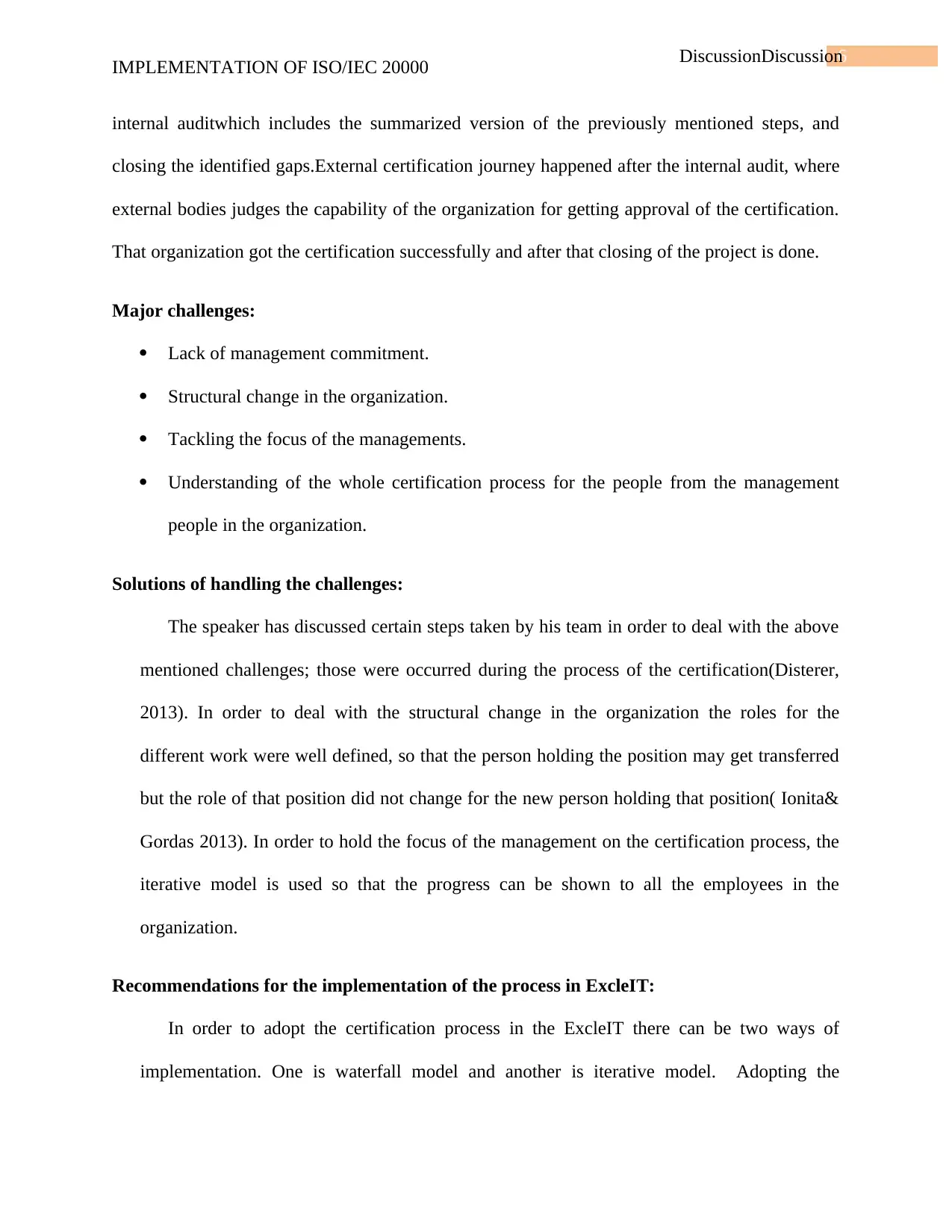
6DiscussionDiscussion
IMPLEMENTATION OF ISO/IEC 20000
internal auditwhich includes the summarized version of the previously mentioned steps, and
closing the identified gaps.External certification journey happened after the internal audit, where
external bodies judges the capability of the organization for getting approval of the certification.
That organization got the certification successfully and after that closing of the project is done.
Major challenges:
Lack of management commitment.
Structural change in the organization.
Tackling the focus of the managements.
Understanding of the whole certification process for the people from the management
people in the organization.
Solutions of handling the challenges:
The speaker has discussed certain steps taken by his team in order to deal with the above
mentioned challenges; those were occurred during the process of the certification(Disterer,
2013). In order to deal with the structural change in the organization the roles for the
different work were well defined, so that the person holding the position may get transferred
but the role of that position did not change for the new person holding that position( Ionita&
Gordas 2013). In order to hold the focus of the management on the certification process, the
iterative model is used so that the progress can be shown to all the employees in the
organization.
Recommendations for the implementation of the process in ExcleIT:
In order to adopt the certification process in the ExcleIT there can be two ways of
implementation. One is waterfall model and another is iterative model. Adopting the
IMPLEMENTATION OF ISO/IEC 20000
internal auditwhich includes the summarized version of the previously mentioned steps, and
closing the identified gaps.External certification journey happened after the internal audit, where
external bodies judges the capability of the organization for getting approval of the certification.
That organization got the certification successfully and after that closing of the project is done.
Major challenges:
Lack of management commitment.
Structural change in the organization.
Tackling the focus of the managements.
Understanding of the whole certification process for the people from the management
people in the organization.
Solutions of handling the challenges:
The speaker has discussed certain steps taken by his team in order to deal with the above
mentioned challenges; those were occurred during the process of the certification(Disterer,
2013). In order to deal with the structural change in the organization the roles for the
different work were well defined, so that the person holding the position may get transferred
but the role of that position did not change for the new person holding that position( Ionita&
Gordas 2013). In order to hold the focus of the management on the certification process, the
iterative model is used so that the progress can be shown to all the employees in the
organization.
Recommendations for the implementation of the process in ExcleIT:
In order to adopt the certification process in the ExcleIT there can be two ways of
implementation. One is waterfall model and another is iterative model. Adopting the
Paraphrase This Document
Need a fresh take? Get an instant paraphrase of this document with our AI Paraphraser
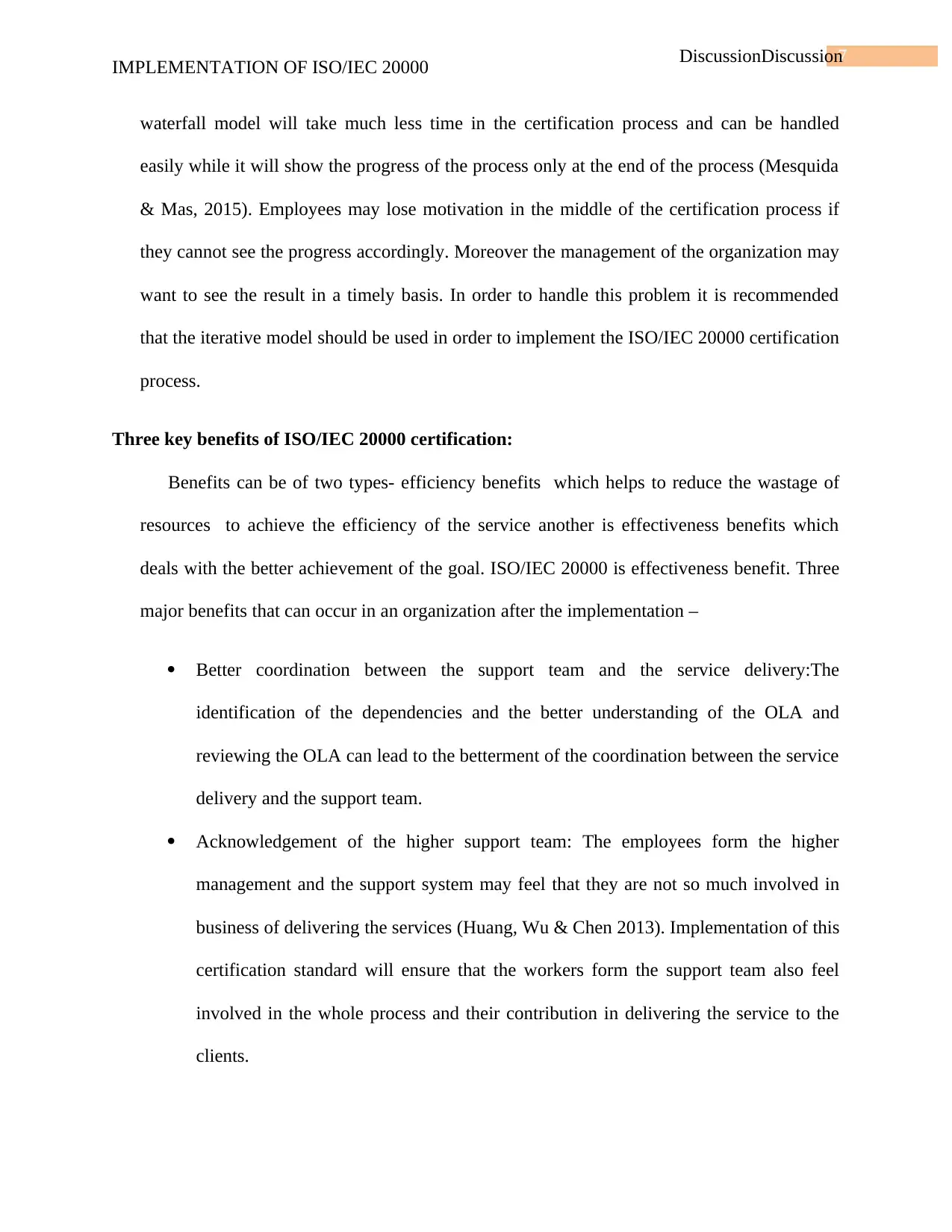
7DiscussionDiscussion
IMPLEMENTATION OF ISO/IEC 20000
waterfall model will take much less time in the certification process and can be handled
easily while it will show the progress of the process only at the end of the process (Mesquida
& Mas, 2015). Employees may lose motivation in the middle of the certification process if
they cannot see the progress accordingly. Moreover the management of the organization may
want to see the result in a timely basis. In order to handle this problem it is recommended
that the iterative model should be used in order to implement the ISO/IEC 20000 certification
process.
Three key benefits of ISO/IEC 20000 certification:
Benefits can be of two types- efficiency benefits which helps to reduce the wastage of
resources to achieve the efficiency of the service another is effectiveness benefits which
deals with the better achievement of the goal. ISO/IEC 20000 is effectiveness benefit. Three
major benefits that can occur in an organization after the implementation –
Better coordination between the support team and the service delivery:The
identification of the dependencies and the better understanding of the OLA and
reviewing the OLA can lead to the betterment of the coordination between the service
delivery and the support team.
Acknowledgement of the higher support team: The employees form the higher
management and the support system may feel that they are not so much involved in
business of delivering the services (Huang, Wu & Chen 2013). Implementation of this
certification standard will ensure that the workers form the support team also feel
involved in the whole process and their contribution in delivering the service to the
clients.
IMPLEMENTATION OF ISO/IEC 20000
waterfall model will take much less time in the certification process and can be handled
easily while it will show the progress of the process only at the end of the process (Mesquida
& Mas, 2015). Employees may lose motivation in the middle of the certification process if
they cannot see the progress accordingly. Moreover the management of the organization may
want to see the result in a timely basis. In order to handle this problem it is recommended
that the iterative model should be used in order to implement the ISO/IEC 20000 certification
process.
Three key benefits of ISO/IEC 20000 certification:
Benefits can be of two types- efficiency benefits which helps to reduce the wastage of
resources to achieve the efficiency of the service another is effectiveness benefits which
deals with the better achievement of the goal. ISO/IEC 20000 is effectiveness benefit. Three
major benefits that can occur in an organization after the implementation –
Better coordination between the support team and the service delivery:The
identification of the dependencies and the better understanding of the OLA and
reviewing the OLA can lead to the betterment of the coordination between the service
delivery and the support team.
Acknowledgement of the higher support team: The employees form the higher
management and the support system may feel that they are not so much involved in
business of delivering the services (Huang, Wu & Chen 2013). Implementation of this
certification standard will ensure that the workers form the support team also feel
involved in the whole process and their contribution in delivering the service to the
clients.
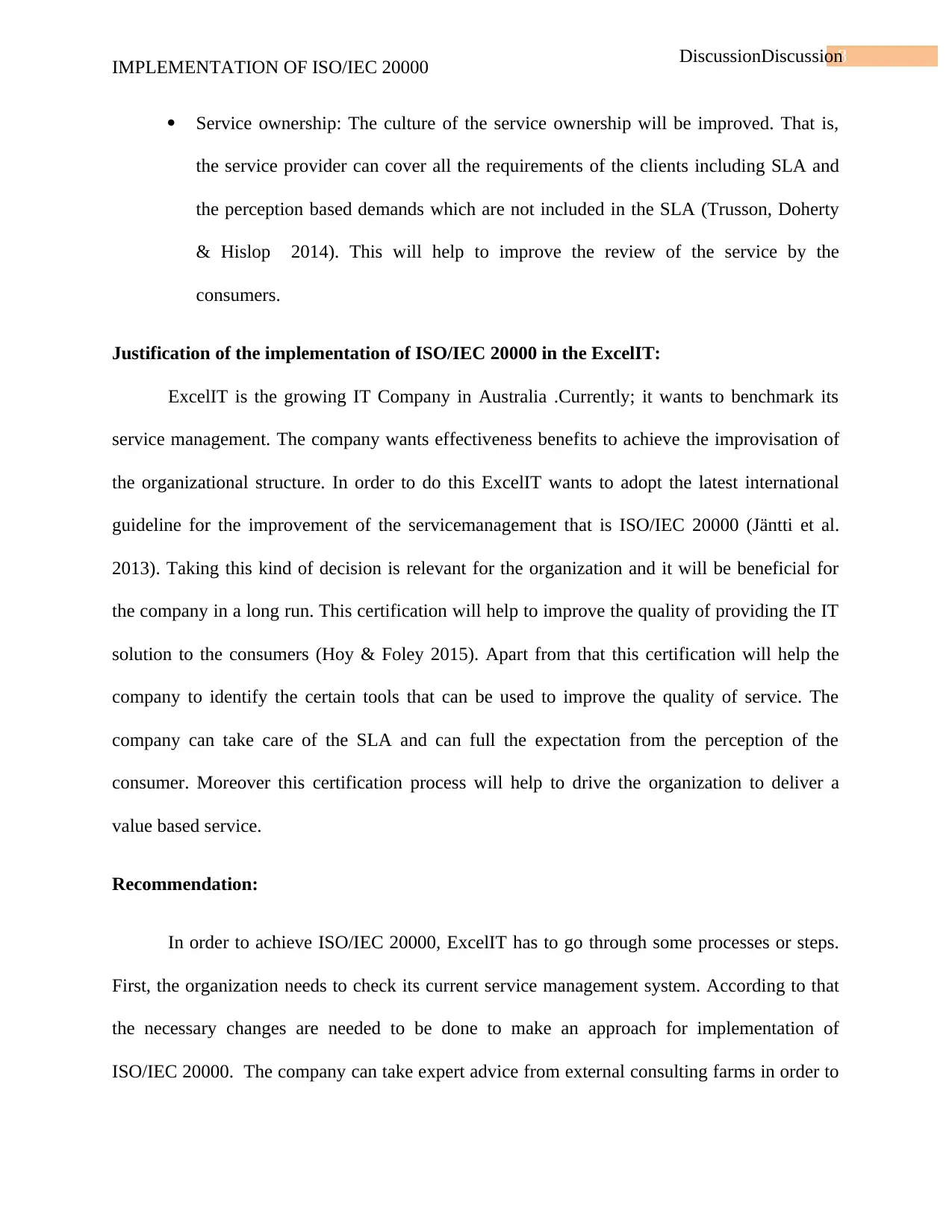
8DiscussionDiscussion
IMPLEMENTATION OF ISO/IEC 20000
Service ownership: The culture of the service ownership will be improved. That is,
the service provider can cover all the requirements of the clients including SLA and
the perception based demands which are not included in the SLA (Trusson, Doherty
& Hislop 2014). This will help to improve the review of the service by the
consumers.
Justification of the implementation of ISO/IEC 20000 in the ExcelIT:
ExcelIT is the growing IT Company in Australia .Currently; it wants to benchmark its
service management. The company wants effectiveness benefits to achieve the improvisation of
the organizational structure. In order to do this ExcelIT wants to adopt the latest international
guideline for the improvement of the servicemanagement that is ISO/IEC 20000 (Jäntti et al.
2013). Taking this kind of decision is relevant for the organization and it will be beneficial for
the company in a long run. This certification will help to improve the quality of providing the IT
solution to the consumers (Hoy & Foley 2015). Apart from that this certification will help the
company to identify the certain tools that can be used to improve the quality of service. The
company can take care of the SLA and can full the expectation from the perception of the
consumer. Moreover this certification process will help to drive the organization to deliver a
value based service.
Recommendation:
In order to achieve ISO/IEC 20000, ExcelIT has to go through some processes or steps.
First, the organization needs to check its current service management system. According to that
the necessary changes are needed to be done to make an approach for implementation of
ISO/IEC 20000. The company can take expert advice from external consulting farms in order to
IMPLEMENTATION OF ISO/IEC 20000
Service ownership: The culture of the service ownership will be improved. That is,
the service provider can cover all the requirements of the clients including SLA and
the perception based demands which are not included in the SLA (Trusson, Doherty
& Hislop 2014). This will help to improve the review of the service by the
consumers.
Justification of the implementation of ISO/IEC 20000 in the ExcelIT:
ExcelIT is the growing IT Company in Australia .Currently; it wants to benchmark its
service management. The company wants effectiveness benefits to achieve the improvisation of
the organizational structure. In order to do this ExcelIT wants to adopt the latest international
guideline for the improvement of the servicemanagement that is ISO/IEC 20000 (Jäntti et al.
2013). Taking this kind of decision is relevant for the organization and it will be beneficial for
the company in a long run. This certification will help to improve the quality of providing the IT
solution to the consumers (Hoy & Foley 2015). Apart from that this certification will help the
company to identify the certain tools that can be used to improve the quality of service. The
company can take care of the SLA and can full the expectation from the perception of the
consumer. Moreover this certification process will help to drive the organization to deliver a
value based service.
Recommendation:
In order to achieve ISO/IEC 20000, ExcelIT has to go through some processes or steps.
First, the organization needs to check its current service management system. According to that
the necessary changes are needed to be done to make an approach for implementation of
ISO/IEC 20000. The company can take expert advice from external consulting farms in order to
You're viewing a preview
Unlock full access by subscribing today!
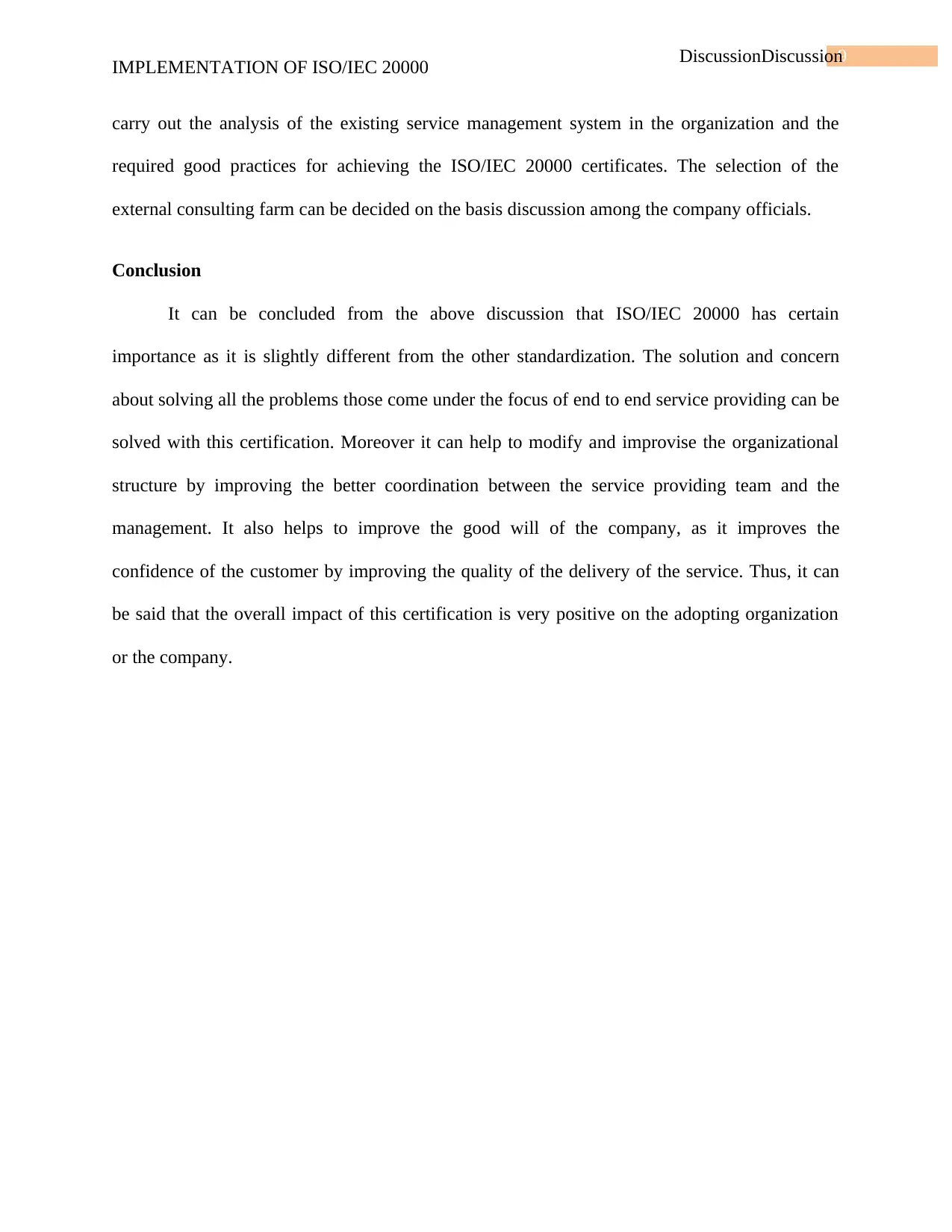
9DiscussionDiscussion
IMPLEMENTATION OF ISO/IEC 20000
carry out the analysis of the existing service management system in the organization and the
required good practices for achieving the ISO/IEC 20000 certificates. The selection of the
external consulting farm can be decided on the basis discussion among the company officials.
Conclusion
It can be concluded from the above discussion that ISO/IEC 20000 has certain
importance as it is slightly different from the other standardization. The solution and concern
about solving all the problems those come under the focus of end to end service providing can be
solved with this certification. Moreover it can help to modify and improvise the organizational
structure by improving the better coordination between the service providing team and the
management. It also helps to improve the good will of the company, as it improves the
confidence of the customer by improving the quality of the delivery of the service. Thus, it can
be said that the overall impact of this certification is very positive on the adopting organization
or the company.
IMPLEMENTATION OF ISO/IEC 20000
carry out the analysis of the existing service management system in the organization and the
required good practices for achieving the ISO/IEC 20000 certificates. The selection of the
external consulting farm can be decided on the basis discussion among the company officials.
Conclusion
It can be concluded from the above discussion that ISO/IEC 20000 has certain
importance as it is slightly different from the other standardization. The solution and concern
about solving all the problems those come under the focus of end to end service providing can be
solved with this certification. Moreover it can help to modify and improvise the organizational
structure by improving the better coordination between the service providing team and the
management. It also helps to improve the good will of the company, as it improves the
confidence of the customer by improving the quality of the delivery of the service. Thus, it can
be said that the overall impact of this certification is very positive on the adopting organization
or the company.
Paraphrase This Document
Need a fresh take? Get an instant paraphrase of this document with our AI Paraphraser
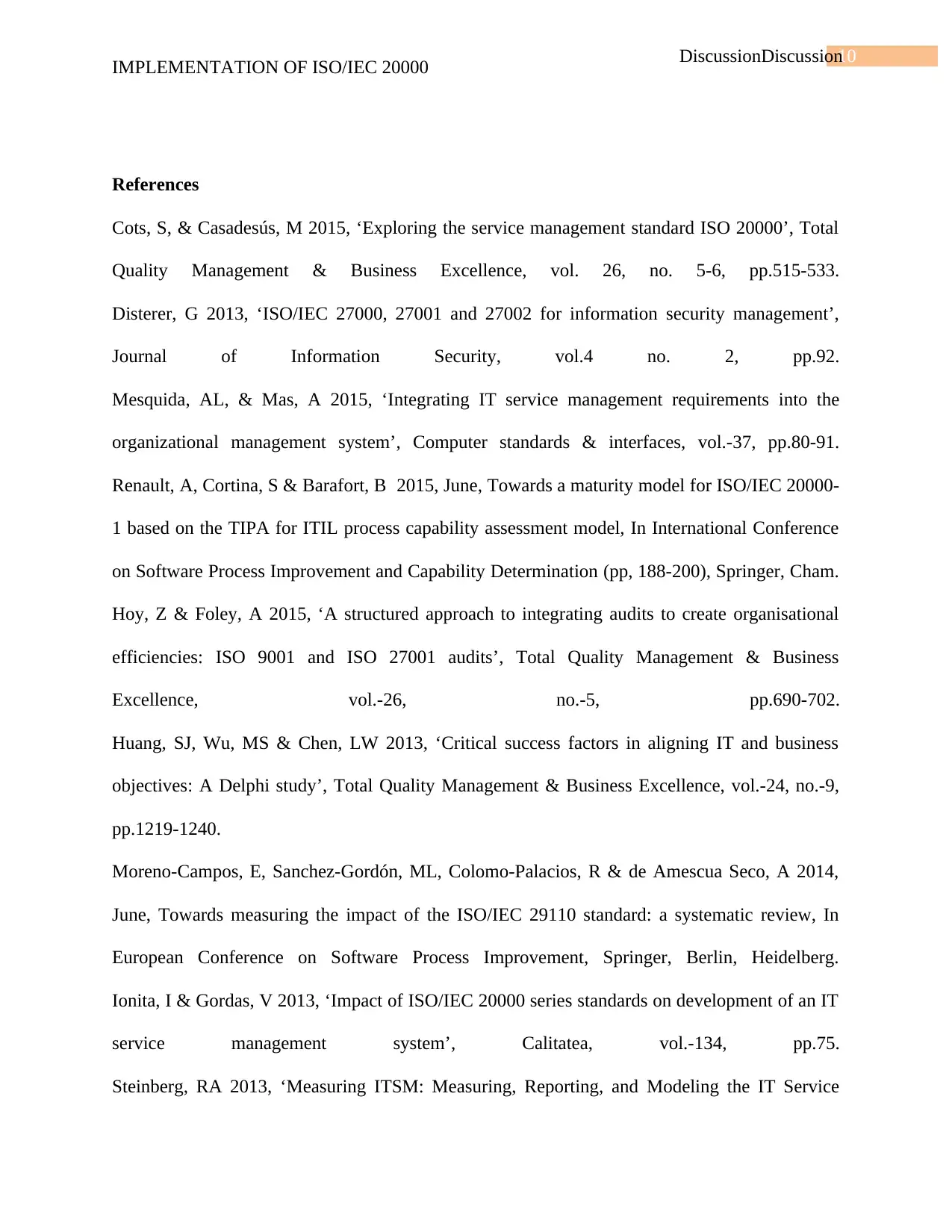
10DiscussionDiscussion
IMPLEMENTATION OF ISO/IEC 20000
References
Cots, S, & Casadesús, M 2015, ‘Exploring the service management standard ISO 20000’, Total
Quality Management & Business Excellence, vol. 26, no. 5-6, pp.515-533.
Disterer, G 2013, ‘ISO/IEC 27000, 27001 and 27002 for information security management’,
Journal of Information Security, vol.4 no. 2, pp.92.
Mesquida, AL, & Mas, A 2015, ‘Integrating IT service management requirements into the
organizational management system’, Computer standards & interfaces, vol.-37, pp.80-91.
Renault, A, Cortina, S & Barafort, B 2015, June, Towards a maturity model for ISO/IEC 20000-
1 based on the TIPA for ITIL process capability assessment model, In International Conference
on Software Process Improvement and Capability Determination (pp, 188-200), Springer, Cham.
Hoy, Z & Foley, A 2015, ‘A structured approach to integrating audits to create organisational
efficiencies: ISO 9001 and ISO 27001 audits’, Total Quality Management & Business
Excellence, vol.-26, no.-5, pp.690-702.
Huang, SJ, Wu, MS & Chen, LW 2013, ‘Critical success factors in aligning IT and business
objectives: A Delphi study’, Total Quality Management & Business Excellence, vol.-24, no.-9,
pp.1219-1240.
Moreno-Campos, E, Sanchez-Gordón, ML, Colomo-Palacios, R & de Amescua Seco, A 2014,
June, Towards measuring the impact of the ISO/IEC 29110 standard: a systematic review, In
European Conference on Software Process Improvement, Springer, Berlin, Heidelberg.
Ionita, I & Gordas, V 2013, ‘Impact of ISO/IEC 20000 series standards on development of an IT
service management system’, Calitatea, vol.-134, pp.75.
Steinberg, RA 2013, ‘Measuring ITSM: Measuring, Reporting, and Modeling the IT Service
IMPLEMENTATION OF ISO/IEC 20000
References
Cots, S, & Casadesús, M 2015, ‘Exploring the service management standard ISO 20000’, Total
Quality Management & Business Excellence, vol. 26, no. 5-6, pp.515-533.
Disterer, G 2013, ‘ISO/IEC 27000, 27001 and 27002 for information security management’,
Journal of Information Security, vol.4 no. 2, pp.92.
Mesquida, AL, & Mas, A 2015, ‘Integrating IT service management requirements into the
organizational management system’, Computer standards & interfaces, vol.-37, pp.80-91.
Renault, A, Cortina, S & Barafort, B 2015, June, Towards a maturity model for ISO/IEC 20000-
1 based on the TIPA for ITIL process capability assessment model, In International Conference
on Software Process Improvement and Capability Determination (pp, 188-200), Springer, Cham.
Hoy, Z & Foley, A 2015, ‘A structured approach to integrating audits to create organisational
efficiencies: ISO 9001 and ISO 27001 audits’, Total Quality Management & Business
Excellence, vol.-26, no.-5, pp.690-702.
Huang, SJ, Wu, MS & Chen, LW 2013, ‘Critical success factors in aligning IT and business
objectives: A Delphi study’, Total Quality Management & Business Excellence, vol.-24, no.-9,
pp.1219-1240.
Moreno-Campos, E, Sanchez-Gordón, ML, Colomo-Palacios, R & de Amescua Seco, A 2014,
June, Towards measuring the impact of the ISO/IEC 29110 standard: a systematic review, In
European Conference on Software Process Improvement, Springer, Berlin, Heidelberg.
Ionita, I & Gordas, V 2013, ‘Impact of ISO/IEC 20000 series standards on development of an IT
service management system’, Calitatea, vol.-134, pp.75.
Steinberg, RA 2013, ‘Measuring ITSM: Measuring, Reporting, and Modeling the IT Service
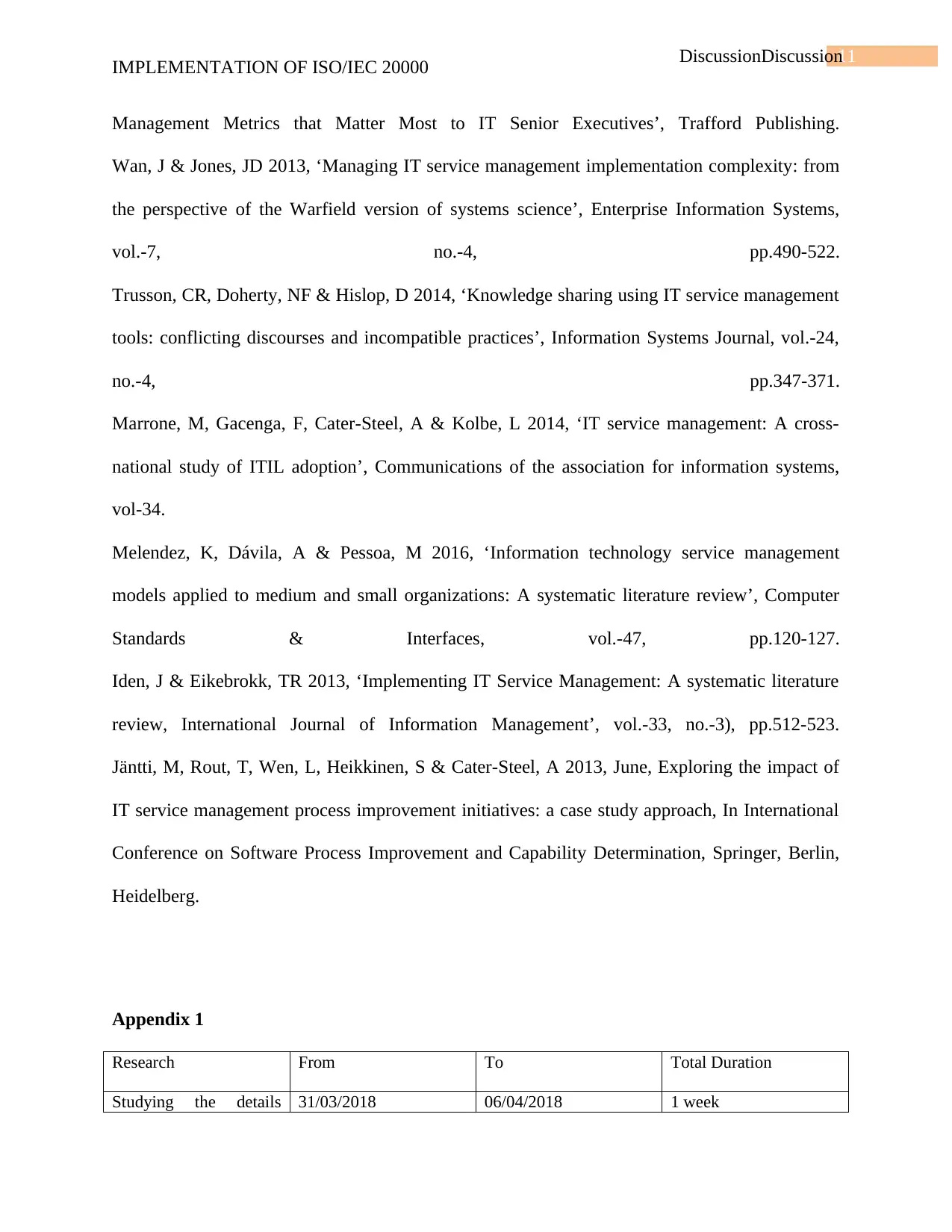
11DiscussionDiscussion
IMPLEMENTATION OF ISO/IEC 20000
Management Metrics that Matter Most to IT Senior Executives’, Trafford Publishing.
Wan, J & Jones, JD 2013, ‘Managing IT service management implementation complexity: from
the perspective of the Warfield version of systems science’, Enterprise Information Systems,
vol.-7, no.-4, pp.490-522.
Trusson, CR, Doherty, NF & Hislop, D 2014, ‘Knowledge sharing using IT service management
tools: conflicting discourses and incompatible practices’, Information Systems Journal, vol.-24,
no.-4, pp.347-371.
Marrone, M, Gacenga, F, Cater-Steel, A & Kolbe, L 2014, ‘IT service management: A cross-
national study of ITIL adoption’, Communications of the association for information systems,
vol-34.
Melendez, K, Dávila, A & Pessoa, M 2016, ‘Information technology service management
models applied to medium and small organizations: A systematic literature review’, Computer
Standards & Interfaces, vol.-47, pp.120-127.
Iden, J & Eikebrokk, TR 2013, ‘Implementing IT Service Management: A systematic literature
review, International Journal of Information Management’, vol.-33, no.-3), pp.512-523.
Jäntti, M, Rout, T, Wen, L, Heikkinen, S & Cater-Steel, A 2013, June, Exploring the impact of
IT service management process improvement initiatives: a case study approach, In International
Conference on Software Process Improvement and Capability Determination, Springer, Berlin,
Heidelberg.
Appendix 1
Research From To Total Duration
Studying the details 31/03/2018 06/04/2018 1 week
IMPLEMENTATION OF ISO/IEC 20000
Management Metrics that Matter Most to IT Senior Executives’, Trafford Publishing.
Wan, J & Jones, JD 2013, ‘Managing IT service management implementation complexity: from
the perspective of the Warfield version of systems science’, Enterprise Information Systems,
vol.-7, no.-4, pp.490-522.
Trusson, CR, Doherty, NF & Hislop, D 2014, ‘Knowledge sharing using IT service management
tools: conflicting discourses and incompatible practices’, Information Systems Journal, vol.-24,
no.-4, pp.347-371.
Marrone, M, Gacenga, F, Cater-Steel, A & Kolbe, L 2014, ‘IT service management: A cross-
national study of ITIL adoption’, Communications of the association for information systems,
vol-34.
Melendez, K, Dávila, A & Pessoa, M 2016, ‘Information technology service management
models applied to medium and small organizations: A systematic literature review’, Computer
Standards & Interfaces, vol.-47, pp.120-127.
Iden, J & Eikebrokk, TR 2013, ‘Implementing IT Service Management: A systematic literature
review, International Journal of Information Management’, vol.-33, no.-3), pp.512-523.
Jäntti, M, Rout, T, Wen, L, Heikkinen, S & Cater-Steel, A 2013, June, Exploring the impact of
IT service management process improvement initiatives: a case study approach, In International
Conference on Software Process Improvement and Capability Determination, Springer, Berlin,
Heidelberg.
Appendix 1
Research From To Total Duration
Studying the details 31/03/2018 06/04/2018 1 week
You're viewing a preview
Unlock full access by subscribing today!
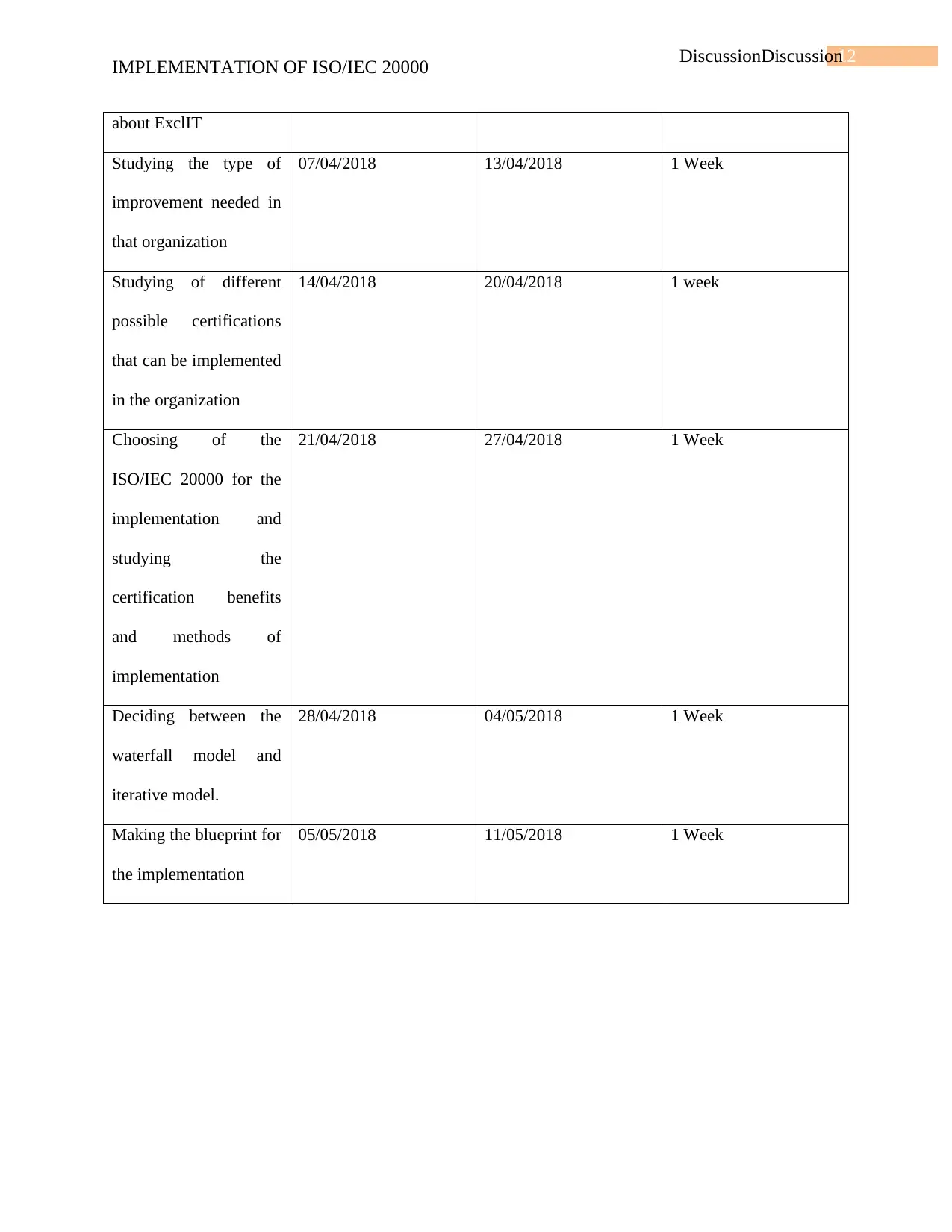
12DiscussionDiscussion
IMPLEMENTATION OF ISO/IEC 20000
about ExclIT
Studying the type of
improvement needed in
that organization
07/04/2018 13/04/2018 1 Week
Studying of different
possible certifications
that can be implemented
in the organization
14/04/2018 20/04/2018 1 week
Choosing of the
ISO/IEC 20000 for the
implementation and
studying the
certification benefits
and methods of
implementation
21/04/2018 27/04/2018 1 Week
Deciding between the
waterfall model and
iterative model.
28/04/2018 04/05/2018 1 Week
Making the blueprint for
the implementation
05/05/2018 11/05/2018 1 Week
IMPLEMENTATION OF ISO/IEC 20000
about ExclIT
Studying the type of
improvement needed in
that organization
07/04/2018 13/04/2018 1 Week
Studying of different
possible certifications
that can be implemented
in the organization
14/04/2018 20/04/2018 1 week
Choosing of the
ISO/IEC 20000 for the
implementation and
studying the
certification benefits
and methods of
implementation
21/04/2018 27/04/2018 1 Week
Deciding between the
waterfall model and
iterative model.
28/04/2018 04/05/2018 1 Week
Making the blueprint for
the implementation
05/05/2018 11/05/2018 1 Week
1 out of 13
Related Documents
Your All-in-One AI-Powered Toolkit for Academic Success.
+13062052269
info@desklib.com
Available 24*7 on WhatsApp / Email
![[object Object]](/_next/static/media/star-bottom.7253800d.svg)
Unlock your academic potential
© 2024 | Zucol Services PVT LTD | All rights reserved.




